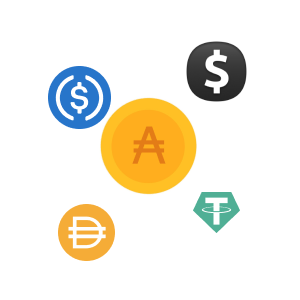Stablecoins


- Stablecoins are tokens that are pegged to assets that have a near constant or stable value, such as the United States Dollar
- Stablecoins can be either centralized or trustless
- Aurei is the first Stablecoin set to launch on the Flare Network
Stablecoins are tokens that are tied to the value of an asset with relatively constant value, typically the US Dollar. This is why they are called Stablecoins. The price coupling of one asset to another is often referred to as “pegged”. Said another way, Stablecoins are pegged to the US dollar, or other assets of stable value.
Stablecoins can serve several purposes and are widely used in the DeFi space. The most common use case for a Stablecoin is to give users the ability to exchange volatility of an asset, or one that’s price changes frequently, to a more stable token such as a USD coin. Stablecoins come in different flavors as we will discuss below. One place you will find Stablecoins is on one side of a Liquidity Pool.
Stablecoins come in different flavors all with differing perceived risks. Below we will briefly go over
the different types and some of their risks.
Here are some examples of Stablecoins:
- USDC
- USDT (Tether)
- Binance USD (BUSD)
- Dai 
- TrueUSD 
- Aurei 
Fiat Backed
These are stablecoins that are supposed to be backed 1:1 by fiat currency. So a USD stablecoin should have its
value in tokens backed by actual US Dollars somewhere. These are stablecoins that are backed by a centralized
entity.
Risks with Fiat Backed Stablecoins are that a centralized entity is the issuer of the token and has to be
trusted in order to ensure it actually has the fiat backed reserves that it says it does.
Crypto Backed
Crypto Backed stablecoins are ones that are backed by other cryptocurrencies. One of the most popular examples
is the ETH backed USD stablecoin DAI. While crypto backed stablecoins have their benefits, such as being
non-custodial, they do come with their own risks.
Because cryptos are currently rather volatile, crypto backed stablecoins need to be over-collateralized in
order to be issued. This means that the crypto’s value you are using to back the stablecoin needs to
oftentimes be 2x the value of the stablecoin itself. For those that are familiar with the Flare Network’s
F-Asset system, an example of over-collateralization is that an F-Asset needs to be backed by 2.5x its value in
FLR. While the current F-Assets aren’t stablecoins, it is an example of crypto backed asset that needs to be
overcollateralized.
Commodity Backed
Stablecoins can be backed by most other forms of value. One example would be a precious metal backed
stablecoin backed by Gold. Commodity Backed stablecoins have the same risks as a fiat backed stablecoin, as they rely on
centralized issuers that may or may not have the reserves required to maintain the peg.

The first Stablecoin set to be launched on the Flare Network is Aurei, created by Trustline Inc. Aurei is an over-collateralized crypto backed stablecoin that represents the value of the US Dollar. Because it is issued on the Flare Network, you can use FLR or any F-Asset to collateralize Aurei.
On top of Aurei being the first stablecoin on the Flare Network, it also has some other cool features. One such feature is that you can use Aurei in Trustline’s Probity vault to lend and borrow. The other, which is something that should not be overlooked, is that you will be able to trustlessly issue Aurei on the XRP Ledger. This is significant because it will be the second trustless asset on the XRP Ledger (with XRP being the first). This means that there isn’t a centralized entity managing the issuance of the asset, which further promotes decentralization. You are now able to create an asset trustlessly on one network, and then issue it without any centralized entity on another.